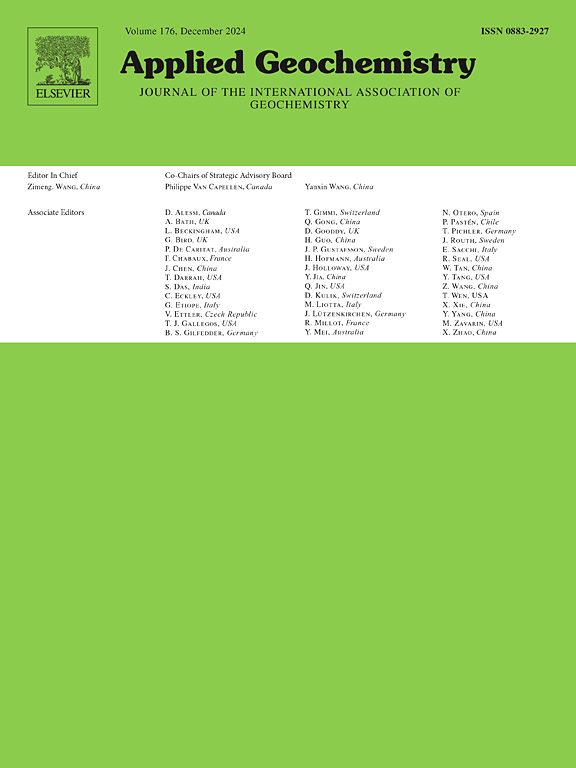Rare earth element patterns in sediments from the Great Lakes basin
IF 3.1
3区 地球科学
Q1 GEOCHEMISTRY & GEOPHYSICS
引用次数: 0
Abstract
This study presents a comprehensive analysis of rare earth element (REE) concentrations in >100 sediment samples from Lakes Erie and Huron, two of the North American Great Lakes. Significant intra- and inter-lake variability in REE concentrations is observed for both lakes Erie and Huron (<10 μg/g < versus <6 mg/g ƩREE, respectively). Light (L) REE were enriched over heavy (H) REE in surface sediment samples across both lakes, particularly in the North Channel of Lake Huron. Sediment cores from both lakes contained REE concentrations that are equally variable over time and correlated with major elements and other trace metals, reflective of the strong control of sediment accumulation rates on REE concentrations. Sequential extractions show that REE are predominantly associated with the residual (silicate) fraction (>50%) and likely originated from geogenic sources (basin weathering). However, considerable REE fractions (up to 16%) were also associated with oxide, phosphate minerals and organic/reducible material, particularly for the LREE. We attribute this apportionment and LREE enrichment to aqueous complexation and export from the water column. Finally, REE normalization and pattern-fitting reveal positive Ce anomalies (up to 16.2) in specific locations that could be indicative of hypolimnic redox gradients, whereas minor Gd and Eu anomalies (0.9 for Eu, and 1.02 for Gd, on average) likely relate to the parent rock signature. Our findings contribute valuable baseline data and insights into the complex interplay of geological, hydrodynamic, and environmental factors influencing REE distribution patterns in these lake sediments.
大湖盆地沉积物中的稀土元素模式
本研究全面分析了来自伊利湖和休伦湖这两个北美五大湖的 100 个沉积物样本中的稀土元素 (REE) 浓度。伊利湖和休伦湖的稀土元素浓度在湖内和湖间存在显著差异(分别为 10 μg/g ƩREE 和 6 mg/gƩREE)。在两湖的表层沉积物样本中,轻质(L)REE 比重质(H)REE 富集,尤其是在休伦湖的北海峡。两个湖泊的沉积物岩心所含的 REE 浓度随时间的变化相同,并与主要元素和其他痕量金属相关,反映了沉积物堆积速率对 REE 浓度的强大控制作用。连续提取结果表明,REE 主要与残余(硅酸盐)部分(50%)有关,很可能来自地质来源(盆地风化)。不过,也有相当多的 REE 部分(高达 16%)与氧化物、磷酸盐矿物和有机/可还原物质有关,尤其是 LREE。我们将这种分配和 LREE 富集归因于水络合作用和水柱输出。最后,REE归一化和模式拟合揭示了特定位置的正Ce异常(高达16.2),这可能表明了低水位氧化还原梯度,而轻微的Gd和Eu异常(Eu平均为0.9,Gd平均为1.02)可能与母岩特征有关。我们的研究结果提供了宝贵的基准数据,有助于深入了解影响这些湖泊沉积物中 REE 分布模式的地质、水动力和环境因素之间复杂的相互作用。
本文章由计算机程序翻译,如有差异,请以英文原文为准。
求助全文
约1分钟内获得全文
求助全文
来源期刊

Applied Geochemistry
地学-地球化学与地球物理
CiteScore
6.10
自引率
8.80%
发文量
272
审稿时长
65 days
期刊介绍:
Applied Geochemistry is an international journal devoted to publication of original research papers, rapid research communications and selected review papers in geochemistry and urban geochemistry which have some practical application to an aspect of human endeavour, such as the preservation of the environment, health, waste disposal and the search for resources. Papers on applications of inorganic, organic and isotope geochemistry and geochemical processes are therefore welcome provided they meet the main criterion. Spatial and temporal monitoring case studies are only of interest to our international readership if they present new ideas of broad application.
Topics covered include: (1) Environmental geochemistry (including natural and anthropogenic aspects, and protection and remediation strategies); (2) Hydrogeochemistry (surface and groundwater); (3) Medical (urban) geochemistry; (4) The search for energy resources (in particular unconventional oil and gas or emerging metal resources); (5) Energy exploitation (in particular geothermal energy and CCS); (6) Upgrading of energy and mineral resources where there is a direct geochemical application; and (7) Waste disposal, including nuclear waste disposal.
 求助内容:
求助内容: 应助结果提醒方式:
应助结果提醒方式:


